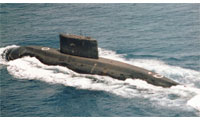
Fig. 1: Image of Submarines
History of inventions does not have a more interesting chapter than that of submarines. Sailing under ocean’s waves was an allure for all the heroes that led to making of this masterpiece.
In 1830s and 40s, various French inventors including Petit Villeroi, Payerne, DeMontgery hadprovided submersible concepts and some of them were actually built too. But only after French Navy became keen in the design offered by naval constructor Charles Brun and Captain Bourgeois, notable progress was made in these wonder machines.
In 1859, Brun and Bourgeois started putting in their efforts on Le Plongeur, which was earliest submarine, independent of human power for propulsion. Motorized by reciprocating engine, compelled by the stored compressed air, this 14 foot could manage standard 5 knots submerged. She was incredible sight with displacement of around 420 tons. This was largest submarine to make a debut before 20th century. The giant size of this submarine was due to storage space required for huge bottles with compressed air. She was also the first ever to utilize compressed air for empting the ballast tanks.
But soon after the launch in 1863, imperfections in Le Plongeur came to the surface. The machine suffered from insufficient stability because of her flatness and length. The system of pistons and pipes used from one end to another end for longitudinal equilibrium control worked slowly. The submarine would tumble downwards at the steep angles and correcting gears would come to action. It also took breaks for surface, where other correction processes would start all over again. After working on it for three years without any notable improvements, experiments on Le Plongeur were abandoned.
Then invention by Narcis Monturiol, a Spanish engineer, came to limelight. He first conceived building submarine to help the coral fishermen. By 1859, 7 m long Ictíneo was all set for first real life test. But its propeller was hand driven by four people. Monturiol began construction on a larger submarine, Ictineo II, in 1862. The length of submarine was 17 m and it displaced 65 tons. Launched in 1864, the bigger submarine’s propeller was operated with help of 16 men.
Ictineo II was equipped with single cannon that could be fired when completely submerged. Due to its bad performance, Monturiol decided to replace human power with steam engine of 6 Hp. And his creation was re-launched in 1867, propelled by one cylinder set in stern of the boat. The submarine did around 13 submersions to 30 m of depth. But the fate of this wonder piece was bad. It was seized by the creditors due to financial problems and was broken up to be sold for the metal as scrap.
Jules Verne acted as an inspiration for submarines pioneers of late 1900and early 2000 centuries. Better known as father of the science fiction, Jules authored Twenty Thousand Leagues Under the Sea in year 1870. Though he lacked formal training in engineering and science, Jules has been an immense source of motivation for submarine inventors. Futuristic submarine for his protagonist named Captain Nemo had inspired many and Simon Lake was one of them. Lake even credited his ever growing interest in Sea exploration to Jules’s Novel. He was pleasantly surprised when he got Congratulations telegram on his Argonaut’s ocean voyage completion from the inspiring author.
In 1872, James McClintock traveled to Nova Scotia to conduct a meeting with the Royal Navy. Reason behind the trip was significant, he wanted to talk about his work in the submarine warfare and also express the desire of building submersible torpedo vessel for the Navy. Though, he had proposed engine that could be driven with ammoniacal gas and all other elements that he considered best for his boat, he was aware of its shortcomings too. Basic problems that were faced by this piece were inexact compass readings, lack of self propelling power and inability to keep a track of horizontal movements. Resurgam, soon followed these submarines. Reverend George Garrett intended on demonstrating 12m vehicle to British Navy and it was not free of mechanical problems.
And Fish torpedo, earliest self propelled torpedo by Navy, was created in 1871 by Naval Torpedo station. Its design was based on physical attributes of Early Whitehead torpedo by Whitehead. Next entered John Phillip Holland, the submarine pioneer of the 20th century who is now called father of modern submarine. He had launched the first ever submersible design in 1875. He determined to separate ballast water and air internally with the help of oiled and flexible silk partitions. Called Holland Boat No. 1, John’s boat was laid in Albany Iron Works, New York. In 1878, this boat was shifted to another Iron Works in Peterson. Weighing 2-1/4 tons, 14 feet long Holland 1 propelled by four horsepower engine. Though he did not get any funding for his first proposal, improvised steam supply in this 14 foot long craft was enough to get funding from Fenian Brotherhood for following prototype.
Holland integrated key concepts that he had figured out about the submarine navigation and confirmed Holland 1 in Fenian Ram in New York. This 19 ton submersible was propelled by Brayton engine 17 horsepower and equipped with dynamite gun for tests at the New York harbor. Consistent progress of Holland came to a halt in 1883 because of internal disagreement among Fenian Brotherhood.
And later that year, Philip Holland met Edmund L. Zalinski who marketed the dynamite gun for Fenian Ram. He hoped to provide financing for building new submarine featuring his own pneumatic gun as chief armament. He also offered Philip Holland a position with his company ,which was quickly accepted by him. Both these men started a company named Nautilus Submarine Boat Company and in the mid 1884, Philip Holland started on with construction of Zalinski Boat.
Since then there has been many improvements in Submarines. Submarines of today are a resultant of combined effort of many brains. After gaining their inspiration from Verne’s Novel or any other source, these heroes have bestowed us with a machine to discover a world under the water. And who knows one of us takes this machinery to another level soon.
Filed Under: Invention Stories


Questions related to this article?
👉Ask and discuss on EDAboard.com and Electro-Tech-Online.com forums.
Tell Us What You Think!!
You must be logged in to post a comment.